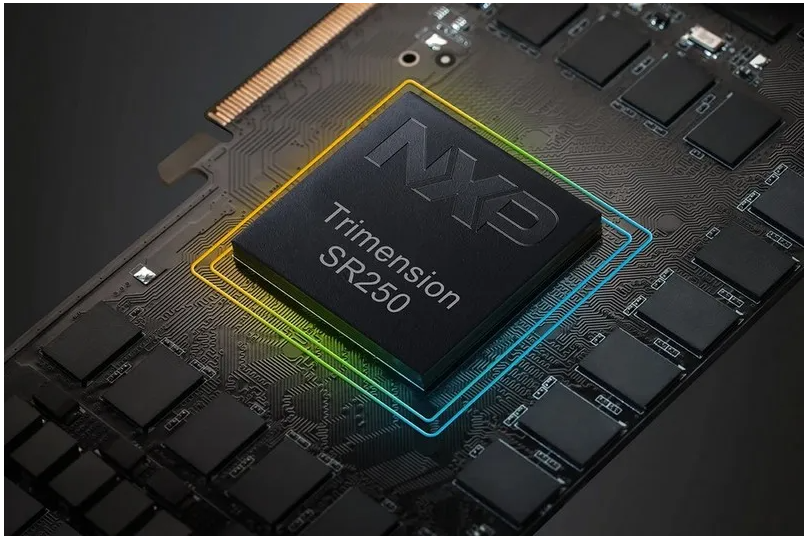NXP has launched the Trimension SR250, a pioneering single-chip solution that integrates short-range ultra-wideband (UWB) radar and secure UWB ranging with on-chip processing. This technology aims to enhance autonomous industrial and IoT applications, providing new functionalities for smart homes and industrial settings. The built-in radar processing capabilities help lower power consumption, boosting overall efficiency. Additionally, NXP offers comprehensive support with firmware, middleware, and sample applications to simplify deployment and speed up the design-in process. This advancement represents a notable step forward in autonomous systems and IoT, targeting improved performance and efficiency.

In an interview with Embedded, Sunil Joji, NXP’s Marketing Director for UWB, highlighted as Trimension SR250 achieves ranging security through multiple features. “Specific to UWB is the use of short radio pulses in combination with a Cryptographically Secure Pseudo Random Number Generator (CSPRNG), which has been specified in IEEE 802.15.4z as part of the Scrambled Timestamp Sequence (STS) waveform. This type of waveform mitigates Early-Detect, Late-Commit (EDLC) attacks, cicada attacks, and other attacks in which malicious parties attempt to reduce the measured distance between two ranging radios,” said Joji.

Sunil Joji, NXP’s Marketing Director for UWB,
The chip’s ability to detect presence, motion, and location not only brings efficiency but also enhances safety and privacy. Its low power consumption and ease of integration into existing IoT ecosystems further streamline the development process for manufacturers.
Features
Operating within the 6-8.5 GHz range, the Trimension SR250 capabilities include secure ranging, angle-of-arrival (AoA) calculations, and support for 3D positioning, enhancing UWB mapping, object detection, and positioning accuracy. This enables features such as automatically turning on or off appliances like lights or televisions based on a person’s presence, providing secure home access, or even non-intrusively monitoring the safety of elderly individuals without the need for cameras. The chip can track workers, assets, and goods in industrial settings while supporting safety features like collision avoidance and danger zone detection.
“The 6.0-8.5 GHz frequency range offers improved obstacle penetration compared to the higher frequencies. Regulations in this frequency range impose strict output power limits on transmitters, resulting in favorable interference properties in high deployment density scenarios. Trimension SR250‘s narrow-band interference resilience, which helps to further ensure stable operation,” said Joji.
The Trimension SR250 from NXP offers highly accurate Time of Flight (ToF) measurements, but achieving precision within ±5 cm in complex environments presents certain challenges. One significant obstacle is receiver desensitization caused by multipath effects, where signals are reflected or diffracted, making it difficult to discern the desired signal from interference. NXP addresses this with the SR250’s ability to detect weak signals even when surrounded by strong, unwanted signals. This capability allows the SR250 to perform well even under heavy multipath interference, ensuring precise measurements in challenging conditions. As Joji noted, “SR250’s ability to detect a weak wanted signal in the presence of a strong unwanted signal greatly helps to handle multipath.”
One of the standout features of the Trimension SR250 is its ability to perform autonomous radar processing on-chip. This reduces the need for continuous host processor activity, significantly lowering energy consumption. In practical terms, the host processor can remain in a low-power sleep mode while the SR250 handles the detection of people or objects. This autonomous capability is essential for smart home and industrial applications, where systems can react to changes in the environment without constant human intervention. For instance, an HVAC system or robotic device could automatically activate or deactivate based on the entry or exit of a person from a specific area.
Moreover, the SR250’s integration with host processors, such as the i.MX family, opens up new possibilities by leveraging AI/ML algorithms. The sensor’s secure range, angle of arrival, and radar sensing capabilities can provide valuable data input for AI/ML applications. These capabilities can be combined with other sensor data to create innovative solutions in both consumer and industrial IoT environments. Joji highlighted that “Trimension SR250’s secure ranging, angle of arrival and radar sensing capabilities can be used as sensor data input to various AI/ML algorithms.”
Whether it’s tracking assets in an industrial setting or enabling seamless home automation, the SR250’s secure and accurate sensing capabilities enhance AI-driven systems in various IoT environments. This synergy between ToF sensing and AI/ML opens the door to smarter, more efficient systems in both the home and industrial sectors.
The SR250 complies with FiRa Consortium’s 3.0 technical specifications, ensuring that it meets industry standards for certification and interoperability. It also supports enhanced security when paired with NXP’s EdgeLock SE051W secure element, making it suitable for applications that require additional security measures.